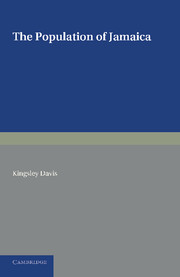Book contents
- Frontmatter
- The Conservation Foundation
- Contents
- List of Figures
- List of Tables
- Preface
- INTRODUCTION
- CHAPTER 1 DEMOGRAPHIC MATERIAL AVAILABLE
- CHAPTER 2 GROWTH OF THE POPULATION
- CHAPTER 3 MAJOR CHARACTERISTICS OF THE POPULATION
- CHAPTER 4 CURRENTS OF EXTERNAL MIGRATION
- CHAPTER 5 INTERNAL MIGRATION
- CHAPTER 6 MORTALITY
- CHAPTER 7 CHANGING PATTERNS OF REPRODUCTION
- CHAPTER 8 FERTILITY, MATING AND ILLEGITIMACY
- CHAPTER 9 GROWTH PROSPECTS
- APPENDICES
- Index of Names
- Index of Subjects
INTRODUCTION
Published online by Cambridge University Press: 05 June 2016
- Frontmatter
- The Conservation Foundation
- Contents
- List of Figures
- List of Tables
- Preface
- INTRODUCTION
- CHAPTER 1 DEMOGRAPHIC MATERIAL AVAILABLE
- CHAPTER 2 GROWTH OF THE POPULATION
- CHAPTER 3 MAJOR CHARACTERISTICS OF THE POPULATION
- CHAPTER 4 CURRENTS OF EXTERNAL MIGRATION
- CHAPTER 5 INTERNAL MIGRATION
- CHAPTER 6 MORTALITY
- CHAPTER 7 CHANGING PATTERNS OF REPRODUCTION
- CHAPTER 8 FERTILITY, MATING AND ILLEGITIMACY
- CHAPTER 9 GROWTH PROSPECTS
- APPENDICES
- Index of Names
- Index of Subjects
Summary
Most tropical areas today suffer from a malady so prevalent and so well known that it strikes no one as peculiar. Yet it is peculiar because it is uniquely modern, and because it exists despite the fact that it would seem easily remediable by techniques far simpler than those used to solve many other modern problems, including physical disease.
The nature of the malady is this: the combination of rapid population growth with widespread poverty. In the past the world has seen plenty of poverty, but the poverty was not associated with a fast increase in numbers. Instead, such demographic expansion as did occur tended to take place among the more successful peoples. Now, however, it is primarily the under-developed parts of the earth, the parts where additional population can be least provided for, that are exhibiting the fastest rates of increase—rates, indeed, which have never before been equalled by any country in human history. This relatively new disorder, this strange social imbalance, complicates the other ills of these regions, makes their future economic progress uncertain, and exacts a greater toll in human frustration than any mere organic illness. It cries aloud for both perceptive understanding and scientific research, but unfortunately it gets little of either.
The island of Jamaica exhibits the malady in its classic, though not in its most extreme, form. In that beautiful place one and a half million people occupy a territory of 4400 square miles. Their average density, 340 persons per square mile, is roughly six times that found in the United States and three times that found in Ireland. Yet, despite this already high density, the population has been growing at a rate which, if continued, would double the number of people on the island every 41 years. In fact, it seems likely that during the next 20 to 40 years the rate of human multiplication may even exceed that of recent decades. In any case, the prospect of continued population increase poses a serious problem.
- Type
- Chapter
- Information
- The Population of Jamaica , pp. xvii - xxiiPublisher: Cambridge University PressPrint publication year: 2013



